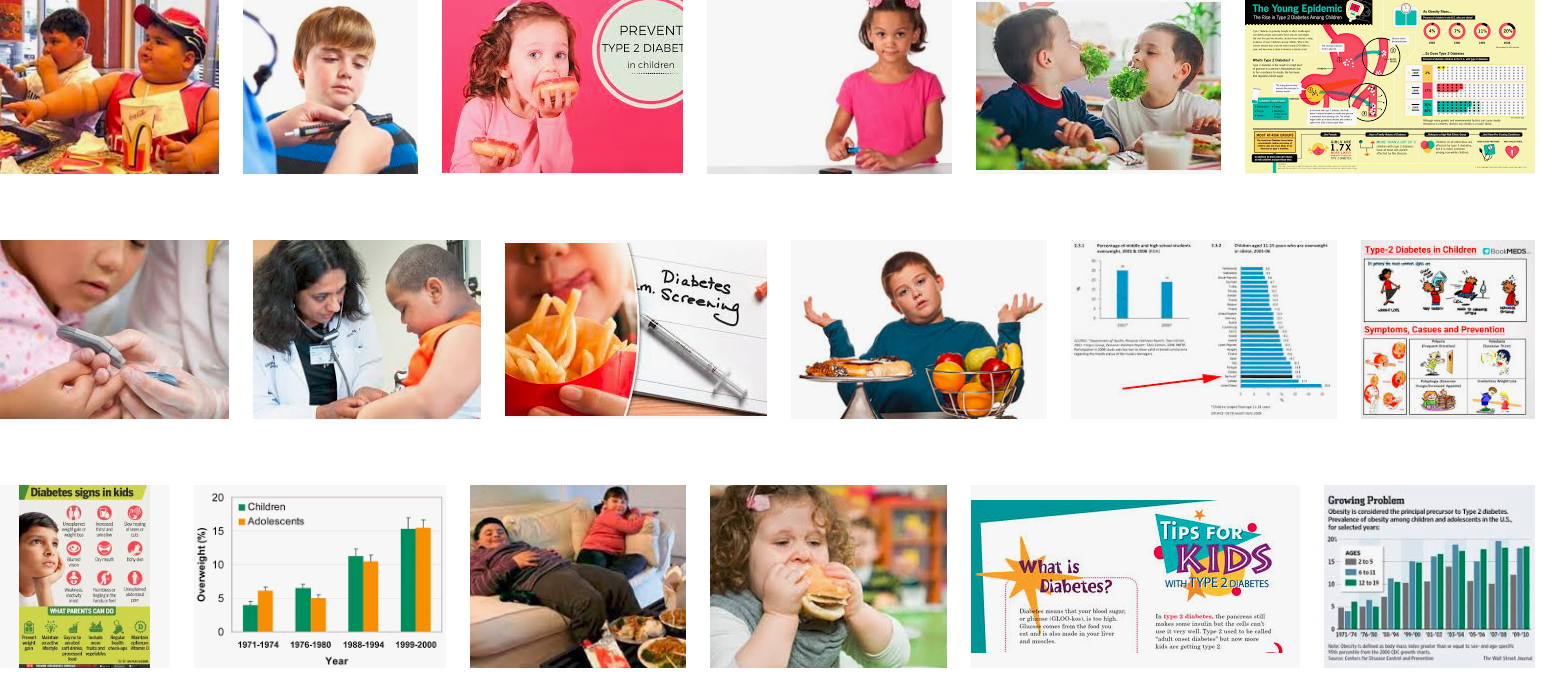A sustained increase in type 2 diabetes (T2D) in children is raising questions on the lifestyle of today’s generation
Sumanth Sharma & Suman Sharma, a couple working in Bangalore has a busy lifestyle courtesy their demanding professions. They often overlooked what their 10 year old daughter Diya was eating. Diya would often eat French fries, crisps & burgers. They noticed soon that she was putting on weight too quickly and would often spend time sitting in front of the television. She would not go out to play with her friends and would often complain of being tired. Concerned they went to their pediatric for a consultation and were in for a shock when they found out Diya has Type 2 Diabetes. “Our immediate reaction was a sense of guilt as we both felt that we could have easily prevented this condition if we had watched what she was eating,” says Suman. In spite of the fact that the family had a history with both parents and paternal and maternal grandfathers having type 2 diabetes, Diya’s condition at her age was certainly concerning. “Diya’s BMI was 28 kg/m2 and she had dark pigmentation under her arm pit (Acanthosis Nigricans). Her Random Blood Sugar was 230 mg/DL and HbA1C was 9.6% Ultrasound abdomen revealed an enlarged fatty liver (grade 1) and bilateral PCOS. She was diagnosed with Type 2 Diabetes and initiated on Metformin 500mg twice a day. Diya had an irregular diet and poor exercise and clinic visits and ultimately required insulin on account of poor control of blood glucose,” says Dr Sreenath Manikanti, senior consultant, Neonatologist & HOD, Fortis La Femme Hospital. For the uninitated, HbA1C test indicates child’s average blood sugar level for the past two to three months. Specifically, the test measures the percentage of blood sugar attached to the oxygen-carrying protein in red blood cells (hemoglobin). HbA1C level below 5.7 percent is considered normal. HbA1C level between 5.7 and 6.4 percent is considered prediabetes. HbA1C level of 6.5 percent or higher indicates type 2 Diabetes. Alternatively a random blood sugar level of 200 mg/dL (11.1 mmol/L) or higher suggests diabetes.
While earlier children were mostly affected by only type 1 diabetes, which is a congenital defect, there has been an increasing incidence of type 2 diabetes, which is considered a lifestyle ailment, among children and young adults in recent years. Most of these children have obesity and family history of type 2 diabetes. “Children affected with Type 1 diabetics is a congenital defect. There has been an increase in incidence of type 2 diabetics, which is considered a lifestyle aliment among children and young adult in the recent years. Most of these children have obesity and family history of type 2 diabetics,” says Dr. Mihir Raut, Internal Medicine, Nanavati Super Speciality Hospital.
The Diabetic Equation
Typically children were getting diagnosed with Type 1 diabetes a situation when the body does not produce insulin. Referred to as juvenile diabetes, type 1 diabetes or insulin dependent diabetes is a condition where the pancreas do not make any insulin. This kind of diabetes cannot be completely reversed with diet, but can be managed quite effectively with the right kind of diet. Since the body doesn’t manufacture its own insulin, the child suffering from type 1 diabetes has to depend on synthetic insulin to manage blood sugar levels. A lot people blame their genes when it comes to diabetes, but genes have a very negligible role to play here. Even if every member of your family is diabetic, you could easily prevent becoming diabetic if you take care of what you eat. Similarly, maybe there’s not a single diabetic person in your family but you could easily earn the distinction of being the first one if you eat a diet high in fat and animal protein. Diabetes and insulin are not a mystery, no one suddenly wakes up with diabetes one fine day. Diabetes is a silently progressing diseases caused by Insulin Resistance. “Insulin resistance is the root cause of diabetes both in children and adults. Whether it is prediabetes, Type 1.5 (this is virtually unknown condition that exists), Type 2 or Type 3 (also known as Alzheihmer’s disease), insulin resistance is what leads to diabetes. Insulin is what carries glucose from your bloodstream to your cells. Inside your cells you have insulin receptors, so every time insulin brings a glucose molecule outside the cell, it talks to the insulin receptors asking them to open the cell to receive the glucose to make energy,” says Mugdha Pradhan, founder and functional nutritionist, Thrive Functional Nutrition Consulting.
Onset of diabetes at a younger age is associated with longer disease exposure and increased risk for chronic complications. There is emerging evidence that genetic mutations unique to the Indian population are contributing to MODY (maturity onset diabetes of the Young). “MODY refers to a novel form of diabetes seen in young individuals especially with family clustering. MODY has autosomal dominant pattern of inheritance and patients had mild or no disease progression and do not require insulin. Although high prevalence of MODY was reported in the mid-1980s in India, the studies were based on clinical assumptions and were not backed by genetic testing. Till date, Type 2 diabetes remains the most common form of the condition, wherein our country ranks second globally,” says Dr. Pradeep Mahajan, Regenerative Medicine Researcher, Stem Rx Bioscience Solutions Pvt. Ltd., Mumbai.
Lifestyle factor
Type 2 diabetes is on the rise primarily due to obesity coupled with sedentary habits. With an increase in buying power, we eat out more often and have a greater access to fatty junk food and sugary drinks. Additionally, most of us under are in a constant stress for time and our traditional whole food diets have been replaced with highly convenient processed food that are nutritionally poor but high in fat and refined carbohydrates. Along with this high fat calorie dense diet there’s been a decrease in physical activity and an increase in sedentary activities thanks to television and mobile phones that have pervaded most of children’s lives. “Contrary to popular belief obesity is not the cause of diabetes. Also, a lot people blame their genes when it comes to diabetes, but genes have a very negligible role to play here. Also diabetes and insulin are not a mystery; no one suddenly wakes up with diabetes one fine day. Diabetes is caused by insulin resistance (which can also lead to excess weight and obesity). Insulin resistance is the root cause of diabetes both in children and adults,” says Pradhan.
See the signs
Symptoms of type 2 diabetes in children may develop gradually. Roughly 40 per cent of children who have type 2 diabetes have no signs or symptoms and are diagnosed during routine physical exams. Other children might experience increased thirst and frequent urination, weight loss, fatigue, blurred and slow-healing sores or frequent infections. Dr Subramanian Kannan, head of department, endocrinology and diabetology, Narayana Health City, Bengaluru says, “We are increasingly seeing a high number of girls and boys who are in classes X to XII being evaluated for early onset diabetes. Parents usually bring their children with complains such as increased facial hair growth (especially in girls), darkening of skin behind the neck, under armpits, groin, excessive weight gain and irregular periods. Abnormalities in liver enzymes, fatty liver on ultrasound are also pointers. These are signs are of insulin resistance and if these clinical features are noted, it is important to screen for diabetes in children.”
Dr Chirantan Bose, vice president, lab operations, Healthians, an online home healthcare service provider adds, “While genetic factors undoubtedly play a role in the development of type 2 diabetes, they alone cannot explain the explosive increase in the prevalence of the disease. Puberty plays a major role in the development of type 2 diabetes mellitus in children as there is an increased resistance to the action of insulin, resulting in hyperinsulinemia.”
Managing matters
Management of diabetes in children is different compared to elders as some of drugs used on adults are not approved for use in children. The common drug used to reduce the insulin resistance is Metformin. “In a few children in whom we cannot differentiate between type 1 or type 2 in the initial clinical visit or if the sugars are high, we use insulin to treat the diabetes. In addition to drugs, counselling of parents as well as the child becomes crucial as children tend to follow the lifestyle of their parents. Further, parents need to restrict the screen time especially during feeding time and motivate the child to do daily physical activity which is appealing to the child,” opines Kannan.
Research has shown that reducing dietary fat has tremendous impact on lowering insulin resistance. Cutting fat from the diet is enough to help your body start the healing process. There is overwhelming evidence that shows that increasing your intake of fruits, starchy vegetables, non-starchy vegetables, legumes, and intact whole grains has a tremendous insulin sensitising effect. Exercise increases the rate at which your muscle and liver cells burn stored fat droplets, and therefore is incredible for boosting insulin sensitivity (cells become less resistant to insulin). Even playing simple outdoor games for an hour each day or going for a cycle ride will help boost insulin sensitivity. Dr Sujit Paul, managing director, StayHappi Pharmacy concludes, “Fortunately, diabetes is treatable with no major side-effects of daily medication among the population in general. Like adults, the risks can be minimised in children by maintaining an ideal body mass, healthy eating and adequate physical activity.”
Changing trends
Apart from regular medications and insulin, newer therapeutic modalities like regenerative medicine and cell based therapy are becoming popular in the management of diabetes.
Dr. Mahajan recounts the case of Tanya Bodke who complained of general weakness, occasional abdominal pain and tingling sensation in toes when she first came to the center. “When diagnosed with diabetes, she was advised lifelong insulin therapy. This came as a shock to the family, as Tanya was only 12 years old at the time of diagnosis and no one in their family reported a history of diabetes. Tanya underwent two sessions of cell based therapy and is now free of insulin and her blood glucose levels are under control for over a year. She does not experience any discomfort as she used to prior to treatment. Tanya has been able to resume her daily activities with renewed vigor and confidence.”
“The rationale behind use of cell based therapy for diabetes is that, stem cells have tremendous regenerative capacity and the flexibility to grow into different types of cells. Progenitor cells in the human body are capable of differentiating in vivo to produce beta cells—the islet cells that manufacture insulin—as well as pancreatic islet cells. Cell-based approach to insulin replacement has been shown to ultimately improve glucose control in diabetes. Furthermore, mesenchymal stem cells have immunomodulatory property that aids in restoring immune homeostasis/balance in the body,” adds Mahajan.
Five Steps to Manage Diabetes in kids
1. Eat a healthy, balanced diet and follow a meal plan regularly
2. Get regular exercise
3. Take medicines as prescribed
4. Monitor blood sugar regularly
5. Attend regular follow ups with the pediatrician


